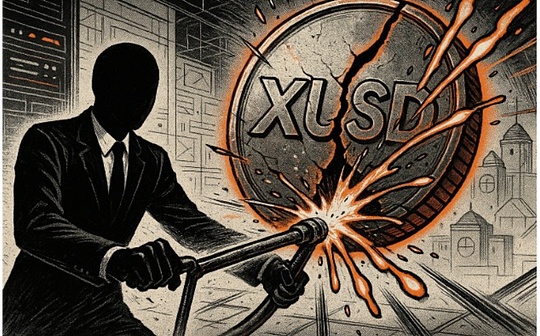
Deng Tong, Bitcoin Vision
On November 3, 2025, Staked Stream suffered a loss of US$93 million due to mismanagement of assets due to the theft of Balancer.The stablecoin xUSD became unanchored and continued to expand its decline in the following days. As of press time, xUSD was only $0.1758.
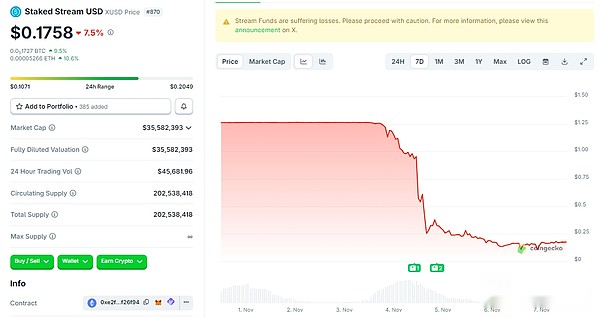 This chain reaction triggered by Stream Finance quickly evolved into a crisis of trust in the role of “Curator” in DeFi protocols.According to DefiLlama data, since October 30, the total lock-up volume (TVL) of vaults managed by Curator has plummeted from US$10.3 billion to US$7.5 billion, with a large amount of funds fleeing in panic, indicating that the market is intensifying concerns about the risks of this model.
This chain reaction triggered by Stream Finance quickly evolved into a crisis of trust in the role of “Curator” in DeFi protocols.According to DefiLlama data, since October 30, the total lock-up volume (TVL) of vaults managed by Curator has plummeted from US$10.3 billion to US$7.5 billion, with a large amount of funds fleeing in panic, indicating that the market is intensifying concerns about the risks of this model.
Trump cryptocurrency adviser David Bailey warned: The credit crisis in the DeFi lending field is evolving into a cryptocurrency liquidity crisis.If the collateral required for margin calls cannot be provided, or the hedging operation fails, the possibility of risk spreading from decentralized finance (DeFi) to centralized finance (CeFi) is extremely high… I hope the situation will not develop to this point, but we still need to remain cautious and avoid counterparty risks.
While the aftermath of the Stream storm is still lingering, the crisis at Morpho Labs has further aggravated industry anxiety.Its treasury utilization rate of hundreds of millions of dollars hit the 100% red line. Due to the delay in the liquidation mechanism, it incurred $700,000 in bad debts, and was forced to suspend withdrawals on chains such as Arbitrum and Plume.
Aave CEO Stani Kulechov criticized Morpho’s custody model for concentrating risk in a shared pool of funds and contrasted it with Aave’s independent market, sparking a broader DeFi discussion.
What is DeFi Curator?What Curators are there?What are the pros, cons and warnings brought by Curator?
1. What is DeFi Curator?
DeFi Curator can be translated into DeFi manager.Curator refers to an individual or team in a decentralized financial protocol who is not the core protocol team but has the ability to create and maintain a strategic vault or asset allocation model.In the DeFi field, they screen, evaluate, integrate and present the most valuable information, opportunities and projects to users through professional knowledge, analysis and tools.They are like “museum curators” or “professional buyers” in the DeFi world. Therefore, DeFi Curator can also be translated into DeFi curator.
DeFi Curators play a dual role: they receive delegated governance power from other token holders, and then express their opinions and exercise that power in governance votes.Their role is similar to that of an asset manager.They will propose appropriate asset allocation strategies: such as which assets to hold, how to optimize returns, how to ensure the safety of funds, etc.They need to ensure the financial soundness of the decentralized autonomous organization (DAO) while maintaining a balance between spending and investment.
In addition, they have another key role: ensuring the security of the protocol.As a result, such critical functions are often handled by multi-signature teams composed of team members and reputable external agencies, sometimes in partnership with professional agencies.
DeFi Curator is an emerging force in the market, but currently relies mainly on mature reward models:
-
Fixed-term contracts (monthly or annual) for ongoing tasks (e.g. parameter management);
-
One-time payments for temporary interventions (e.g., code reviews);
-
Protocol revenue share (e.g. pool fees on Morpho).
Blockchain’s inherent low transfer costs and ease of tokenization provide support for managers to develop new financing methods.
2. What are the important DeFi Curators on the market?
In the current DeFi ecosystem, the DeFi Curator model has been widely used in scenarios such as treasury management, liquidity mining, and synthetic asset issuance.
1.MEV Capital TVL: US$955.77 million
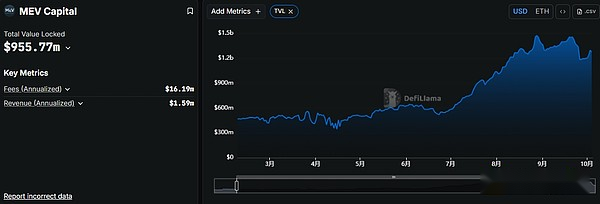
The DeFi trust crisis caused by this Stream is inseparable from MEV Capital.MEV Capital is the leading cooperation Curator in the Stream Finance ecosystem. The two are deeply bound through a business agreement of “strategic authorization-fund custody-income sharing”.As a professional institution introduced by Stream, MEV Capital is responsible for managing the asset allocation of its core income treasury.
MEV Capital used two major operations to push Stream into the abyss: MEV Capital invested more than 60% of its custody funds (approximately $105 million) into the opaque off-chain cryptocurrency options market, adopting a “sell volatility” strategy – that is, earning premiums by selling call/put options, essentially betting that the market will maintain a narrow range of fluctuations.This strategy can obtain stable returns during a stable period, but will face huge risks once extreme market conditions occur; the actual capital leverage ratio is increased to 5 times through recursive lending, resulting in a trading exposure of US$875 million in custodial funds of US$175 million.When the Balancer theft incident triggered a market crash, its option positions triggered a large-scale liquidation, and the losses quickly penetrated the margin layer and directly swallowed up the user’s principal.
The key mechanism used by Stream is Recursive Looping. Stream itself explains that its strategy includes continuously borrowing/reinvesting assets to improve capital efficiency.But this also increases systemic risks and leads to leverage risks.
Anonymous on-chain trader “Cbb0fe” once warned that Stream’s on-chain data shows that xUSD’s backing assets are only about 170 million US dollars, but the borrowing amount has reached 530 million US dollars, and through the protocol’s “recursive loop” strategy, the leverage ratio exceeds 4 times.In a recent article defending the strategy, Stream explained: “Recursive looping is when a protocol cycles through its own assets to capture interest rate differentials.”
However, controversy erupted when users discovered that Stream had allegedly amassed an undisclosed “insurance fund” from profits: a user who goes by the pseudonym chud.eth accused the team of keeping “60% of the undisclosed fee” and not properly segregating it from the strategies the team claimed to protect against.Stream responded that the intention “is for these funds to remain available as an insurance fund,” citing internal communications and investor updates but admitting they had been “less than transparent in terms of how the insurance fund operates.”
2.Re7 Labs TVL: $279.72 million
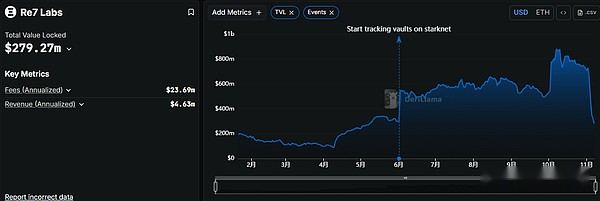
Re7 Labs and MEV Capital are both Stream’s head Curators.The scale of funds managed by Re7 Labs once accounted for more than 25% of Stream’s total locked-up volume, approximately US$125 million.
This US$125 million is mainly targeted at three high-risk areas: US$65 million in the Balancer liquidity pool without any decentralized insurance; US$40 million deployed in emerging public chain mining, which has the risk of smart contract vulnerabilities and project runaways; US$20 million deployed in off-chain perpetual contracts, using more than 10 times leverage for long and short transactions.
Just yesterday, the utilization rate of the fund pool managed by MEV Capital and Re7 Labs on the Lista DAO platform hit 99%, triggering mandatory liquidation.
3. Gauntlet TVL: $2.018 billion
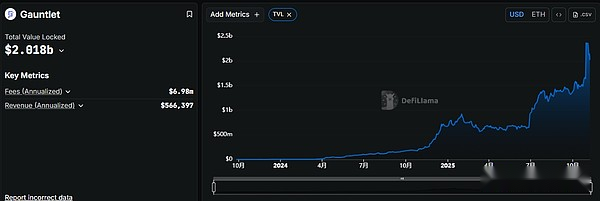
The core of Gauntlet’s operational logic is to place AI decision-making within a strict manual controllable framework. Through AI-driven quantitative analysis technology, it provides risk parameter calibration, policy compliance review and crisis emergency response services for top protocols such as Aave, Compound, and Uniswap, filling the “risk management and control gap” shortcomings in the traditional Curator model.
In the deUSD de-anchoring incident, Gauntlet urgently suspended Compound’s withdrawal function and used “lock-in and stop-loss” to avoid the spread of bad debts. Similar operations were 3 hours faster than Aave’s manual intervention, reducing losses by approximately US$120 million.
4. Steakhouse Financial TVL: $1.298 billion

Steakhouse has fueled the rise of the tokenized real-world asset industry by bringing U.S. Treasury bonds and private credit assets to MakerDAO.
Steakhouse leverages Morpho’s infrastructure to create institutional-grade yield strategies by allocating and rebalancing deposits across Morpho’s diverse lending markets.This allows them to focus on their core expertise: stablecoins, complex risk analysis and portfolio optimization.As a result, Steakhouse has become the largest stablecoin risk manager on Morpho and a provider for fintech companies, exchanges, and institutions to create robust stablecoin yield products with a DeFi backend.
Steakhouse Financial is now the largest manager on Morpho, managing 48 vaults on Ethereum, Base, Katana, Polygon, Unichain, and Arbitrum, generating over $500,000 in annual recurring revenue.
5.K3 Capital TVL: $482.42 million
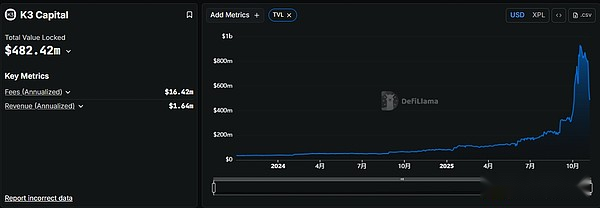
K3 Capital is positioned as an institutional-level Curator, focusing on providing compliant on-chain asset allocation and risk management services for institutions and individual users. It is different from income aggregation platforms such as Stream Finance that focus on retail users. Its services focus more on the refined management needs of professional investors and institutional funds.
Its landmark case is its in-depth cooperation with the decentralized leveraged lending protocol Gearbox Protocol.Through Gearbox’s original “pool-to-account” model, K3 Capital launched a customized USDT credit market. Borrowing users can use USDT mortgage to obtain up to 10 times leverage, and invest funds in DeFi protocols with higher compliance such as Ethena, Sky, and Pendle.
According to data from ChainUnified, K3 Capital manages a capital lockup (TVL) of US$224.6 million and is deployed on the five major blockchains of Avalanche, Unichain, Binance, Ethereum, and BOB.
3. Advantages, Disadvantages and Warnings of Curator
Due to its high professional capabilities, Curator can help users lower the investment threshold and enter the market easily without having to understand complex leverage mechanisms.Curators are usually teams with research and modeling capabilities (funds, risk laboratories, etc.) that can dynamically adjust parameters based on market fluctuations, on-chain data, and liquidation risks.For example, K3 Capital designed the USDT credit market strategy for Gearbox. Users only need to deposit assets to enjoy an annualized return of 8%-12%, which is 3 times higher than the return from self-operation.
But many Curators use complex loops or synthetic asset structures, which increases risk.For example, the key mechanism adopted by Stream is recursive loop. Once there is a confidence crisis or external shock in the market, this “circular lending + multi-protocol mortgage” structure will be very fragile.
Curator also has transparency issues.Most Curators only disclose historical returns and deliberately conceal key risk information.Stream users didn’t know until after the storm that the actual leverage of MEV Capital was 5 times, and xUSD-backed assets were only $170 million but had $530 million in borrowed money.
Curator also faces the risk of over-centralization of assets.Before the Stream storm, the funds managed by MEV Capital and Re7 Labs accounted for 85% of the total TVL, and both had heavy positions in the Balancer protocol. Once the Balancer was stolen, Stream itself would be affected.
Therefore, the future development direction of DeFi Curator must be based on high transparency.Curators should proactively disclose their strategy structure, collateral, leverage multiples, liquidation mechanism, etc.The true mortgage status of assets, debt structure, and remortgage chain should be externally verifiable.Curator should also abandon the high-leverage gambler mentality and focus on long-term value investment.Users need to judge whether the Curator is reliable through on-chain data.
Conclusion
It has been four days since the thunderstorm of Stream, but it remains to be seen whether it can be restarted, whether it can properly repay assets, and whether it can restore trust. Stream’s life or death is still uncertain, and the entire encryption industry’s trust in DeFi has also suddenly dropped.
Although bubbles are beautiful, they will eventually burst.Curator is the bridge between ordinary users and DeFi finance. Curator should not maximize returns as its ultimate goal, but should focus on real long-term value investment.


